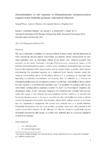Mostrar o rexistro simple do ítem
Characterization of cell response in Chlamydomonas moewusiicultures exposed to the herbicide paraquat: Induction of chlorosis
| dc.contributor.author | Prado, Raquel | |
| dc.contributor.author | Rioboo, Carmen | |
| dc.contributor.author | Herrero, Concepción | |
| dc.contributor.author | Cid, Ángeles | |
| dc.date.accessioned | 2014-09-09T10:22:16Z | |
| dc.date.available | 2014-09-09T10:22:16Z | |
| dc.date.issued | 2011-03 | |
| dc.identifier.citation | Prado R, Rioboo C, Herrero C, Cid Á. Characterization of cell response in Chlamydomonas moewusiicultures exposed to the herbicide paraquat: Induction of chlorosis. Aquatic Toxicology. 2011;102(1-2):10-7. | es_ES |
| dc.identifier.uri | http://hdl.handle.net/2183/12499 | |
| dc.description.abstract | [Abstract] The use of herbicides constitutes the principal method of weed control, but the introduction of these compounds into the aquatic environment can provoke severe consequences for non-target organisms such as microalgae. Effects of the widely used herbicide paraquat were assessed on the green freshwater microalga Chlamydomonas moewusii by means of the analysis of its photosynthetic pigment content, using a traditional spectrophotometric technique that provides population bulk measurements, and by means of flow cytometry, which allowed characterizing the microalgal response at a single-cell level. Results obtained reveal that paraquat concentrations above 50 nM induce chlorosis in a percentage of microalgal cells depending on herbicide concentration and exposure time, as reflected by a reduced cell chlorophyll autofluorescence and pigment content of the biomass. Cell viability in these cultures was also reduced in a concentration dependent way. The possibility of analysing chlorotic and non-chlorotic subpopulations separately allowed the study of morphological properties and physiological status of both cell types, leading to the conclusion that chlorotic cells are non-viable cells, based on their reduced size and complexity and their inability to be stained in the fluorescein diacetate assay. In the case of non-chlorotic cells, cell viability was reduced with the increase of paraquat concentration. Non-chlorotic cells in these cultures showed an increased size and complexity in comparison with control cells, probably due to a growth inhibition. Chlorophyll fluorescence was the most sensitive parameter since even cells exposed to the lowest concentration assayed, 50 nM, although not chlorotic, showed a significantly reduced chlorophyll fluorescence with respect to control cells, reflected also by a reduced chlorophyll content of the biomass. | es_ES |
| dc.description.sponsorship | Galicia: Consellería de Innovación, Industria e Comercio; 08MDS020103PR | |
| dc.description.sponsorship | Ministerio de Educación y Ciencia; CGL2004-02037 . | es_ES |
| dc.language.iso | eng | es_ES |
| dc.relation.uri | http://dx.doi.org/10.1016/j.aquatox.2010.12.013 | es_ES |
| dc.subject | Chlorosis | es_ES |
| dc.subject | Viability | es_ES |
| dc.subject | Paraquat | es_ES |
| dc.subject | Chlamydomonas | es_ES |
| dc.subject | Flow cytometry | es_ES |
| dc.subject | Chlorophyll fluorescence | es_ES |
| dc.title | Characterization of cell response in Chlamydomonas moewusiicultures exposed to the herbicide paraquat: Induction of chlorosis | es_ES |
| dc.type | info:eu-repo/semantics/article | es_ES |
| dc.rights.access | info:eu-repo/semantics/openAccess | es_ES |






